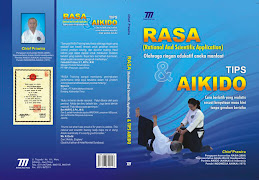Komunitas HE
Belajar bahasa asing
dengan metode
Flowing Oral Practice
Belajar bahasa asing minimal harus untuk mencapai 5 keterampilan berbahasa asing, yaitu:
1. Mampu dengar dan mengerti
2. Mampu bicara dengan baik, benar, dan lancar
3. Mampu baca dan mengerti
4. Mampu tulis (mengarang) dengan baik dan benar
5. Mampu lulus dengan nilai tinggi dalam ujian bahasa dalam bentuk apapun
Metode pembelajaran lisan FLOWING ORAL PRACTICE dapat membuat seseorang mencapai 7 keterampilan berbahasa asing, yaitu:
1. Mampu dengar dan mengerti
2. Mampu bicara dengan baik, benar, dan lancar
3. Mampu baca dan mengerti
4. Mampu tulis (mengarang) dengan baik dan benar
5. Mampu lulus dengan nilai tinggi dalam ujian bahasa dalam bentuk apapun
6. Mampu alih bahasa dengan benar
7. Mampu mengajar dengan baik, benar, cepat, dan mudah
Kunci metode FLOWING ORAL PRACTICE:
1. Pelatihan secara lisan untuk segala pembelajaran (tugas mengarang pendek / panjang juga dilakukan secara lisan)
2. Pembelajaran vocabulary dan usage yang sistematis dan metodologis
3. Proses pembelajaran dengan metode What-Why-How, Spoken Fingers dan Circle Training
4. Materi pembelajaran memakai Huang Hexiang's Learning Dictionary (bukan memakai buku pelajaran biasa)
Pelatihan Bahasa Inggris cara Flowing Oral Practice, temuan Mr. Huang He-xiang
Tahap pertama:
1. Belajar mengucapkan dengan benar simbol-simbol fonetik dan abjad bahasa Inggris
2. Belajar mengeja dengan lancar dan benar kata-kata Inggris
Tahap kedua:
1. Mempelajari kata-kata yang sering dipakai (Vocabulary)
2. Mempelajari cara menggunakan kata-kata dengan benar tersebut dalam kalimat (Usage & Grammar)
3. Mempelajari cara memakai kamus (untuk pelatihan normatif dan refleksif)
4. Pelatihan mendengar dan menirukan / mengucapkan kembali
5. Pelatihan bicara / presentasi dengan benar, jelas, lancar, dan spontan
6. Pelatihan membaca dengan lancar dan benar
7. Pelatihan mengarang secara lisan
Tahap ketiga:
1. Pelatihan pendalaman mandiri
2. Pelatihan alih-bahasa secara lisan dan spontan
3. Pemahaman ujian internasional model TOEFL, IELTS, SAT, dll.
4. Pelatihan mengajar Bahasa Inggris (cara Mr. Huang He-xiang)
Materi Pelatihan:
1. Kamus yang direkomendasikan
2. Audio kaset / cd
Pelatihan Bahasa Tionghoa (Han-yu) cara Flowing Oral Practice, temuan Mr. Huang He-xiang
1. Belajar mengucapkan dengan benar pinyin (dan zhuyin)
2. Belajar menulis bentuk goresan aksara Tionghoa
3. Belajar urutan tulis aksara Tionghoa
Tahap kedua:
1. Mempelajari kata-kata yang sering dipakai (Vocabulary)
2. Mempelajari cara menggunakan kata-kata dengan benar tersebut dalam kalimat (Yu-fa / Usage)
3. Mempelajari cara memakai kamus (untuk pelatihan normatif dan refleksif)
4. Pelatihan mendengar dan menirukan / mengucapkan kembali
5. Pelatihan bicara / presentasi dengan benar, jelas, lancar, dan spontan
6. Pelatihan membaca dengan lancar dan benar
7. Pelatihan mengarang secara lisan
Tahap ketiga:
1. Pelatihan pendalaman mandiri
2. Pelatihan alih-bahasa secara lisan dan spontan
3. Pemahaman ujian internasional model HSK
4. Pelatihan mengajar Bahasa Tionghoa / Han-yu (cara Mr. Huang He-xiang)
Materi Pelatihan:
1. Kamus yang direkomendasikan
2. Audio kaset / cd
Pelatihan Bahasa Jepang cara Flowing Oral Practice, temuan Mr. Huang He-xiang
Tahap pertama:
1. Belajar mengucapkan dengan benar simbol-simbol hiragana dan katakana
2. Belajar menulis bentuk goresan huruf Kanji
3. Belajar urutan tulis huruf Kanji
Tahap kedua:
1. Mempelajari kata-kata yang sering dipakai (Vocabulary)
2. Mempelajari cara menggunakan kata-kata dengan benar tersebut dalam kalimat (Usage & Grammar)
3. Mempelajari cara memakai kamus (untuk pelatihan normatif dan refleksif)
4. Pelatihan mendengar dan menirukan / mengucapkan kembali
5. Pelatihan bicara / presentasi dengan benar, jelas, lancar, dan spontan
6. Pelatihan membaca dengan lancar dan benar
7. Pelatihan mengarang secara lisan
Tahap ketiga:
1. Pelatihan pendalaman mandiri
2. Pelatihan alih-bahasa secara lisan dan spontan
3. Pemahaman ujian internasional model Noryoku Shiken
4. Pelatihan mengajar Bahasa Jepang (cara Mr. Huang He-xiang)
Materi Pelatihan:
1. Kamus yang direkomendasikan
2. Audio kaset / cd
Informasi:
Komunitas HE di Surabaya
Telepon: 031 - 8700076
Seksi: Bahasa


 1. Someone comes near and suddenly wants to hurt you by
1. Someone comes near and suddenly wants to hurt you by

